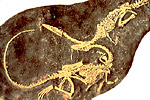Paleontology and geologyThe Precambrian: The Precambrian in New Mexico is represented by granite found in the cores of many of the state’s mountain ranges. No Precambrian sedimentary rocks or fossils are known.
The Paleozoic: In contrast, the Paleozoic is well represented by sedimentary rocks and fossils. A shallow sea covered much of southern and western New Mexico during the Cambrian through the Silurian. Trilobites, brachiopods, nautiloids, and other marine invertebrates flourished in the warm waters. During the Carboniferous, New Mexico was an archipelago of islands rising from the shallow, warm seaways. On land, lush vegetation grew in areas of dense forests and swamps, while clams, brachiopods, and other organisms inhabited the sea floor. In the Early Permian, the climate became drier. The broad river floodplains were replaced by dune fields and a shallow, hypersaline sea. When more normal marine conditions returned during the Middle Permian, the huge reef at El Capitan in southeastern New Mexico developed.
The Mesozoic: Mesozoic rocks and fossils are common in New Mexico. During the Triassic, a seasonally arid climate supported heavily vegetated floodplains, where Coelophysis, one of the earliest dinosaurs, lived. Arid conditions continued into the Jurassic and giant sauropod dinosaurs roamed the coastal plains. By the Cretaceous, the sea returned and flooded the eastern part of New Mexico. Dense jungles and coal-forming swamps hugged the coastline. Dinosaurs flourished on land, while the warm, muddy sea to the east was home to oysters, ammonites, and other sea creatures.
The Cenozoic: During the Early Tertiary, a mountain-building episode turned much of New Mexico into ranges and basins. Magnolias and garfish left their remains in sediments deposited in river floodplains and lakes. Volcanic eruptions were frequent. Later in the Tertiary, the crust opened along the Rio Grande and formed a chain of rift basins that filled with sediments. Large mammals wandered the landscape. During the Quaternary, the Rio Grande became established as the main river system in New Mexico. Glaciers formed in the mountains and mammoths, camels, and other mammals flourished in the cooler climate. |

